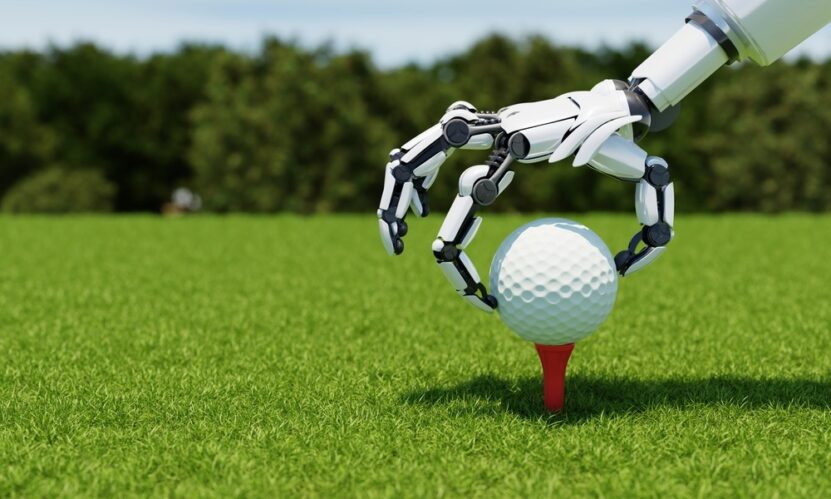In 2025, the term AI in music is no longer limited to the world of art or entertainment. It’s rapidly expanding into unexpected areas—including sports. One of the most intriguing developments is how AI-generated music is being used to improve focus, rhythm, and mental performance in golf.
Golf, often described as a sport of precision and patience, relies heavily on mental clarity and consistent routine.
Every swing, every step on the course, and every breath can impact a player’s performance.
And now, with the integration of artificial intelligence in music, athletes are exploring new ways to regulate their emotions, timing, and mindset through personalized sound environments.
From Background Noise to Smart Soundscapes

Traditionally, music on the golf course was limited to background playlists played during practice or on casual rounds. But in 2025, AI in music has changed that. Golfers now have access to dynamic soundscapes that adapt in real time to their body movements, heart rate, and even stress levels.
These soundscapes are generated by AI models that analyze biometric and environmental data.
For example, if a player’s heart rate begins to spike during a critical putt, the AI might subtly shift the background music toward a slower tempo and warmer harmonies to promote calmness.
Conversely, if a golfer is losing energy or rhythm, the system can introduce more rhythmic elements to reestablish internal pacing.
Unlike traditional playlists, these AI-generated sound environments are not just reactive—they’re predictive.
Based on previous performance data, mood patterns, and external conditions (like wind or crowd noise), the AI adjusts the musical experience before the player even realizes something has shifted.
It acts like an invisible coach, communicating through tone, tempo, and atmosphere.
Training the Brain, Not Just the Body
Golfers have long practiced their swings, studied their putting lines, and refined their physical form. But elite players know that mental training is just as important as physical repetition. That’s where AI in music steps in as a new form of cognitive support.
In training facilities around the world, golfers are now using AI-composed soundscapes during meditation, visualization exercises, and mental rehearsal. These pieces are tailored to induce specific mental states—such as focus, relaxation, or emotional reset—based on each golfer’s psychological profile.
The AI doesn’t compose music randomly. It uses input from sensors (brainwave monitors, heart rate straps, motion detectors) to generate compositions in real time.
These are not necessarily traditional songs, but ambient layers of tones and textures designed to influence the nervous system. Over time, players can condition themselves to associate certain musical cues with deep concentration, muscle memory, or peak performance states.
Tempo and Rhythm in the Swing

There’s also a physical aspect to how AI in music is being used in golf. Swing tempo and rhythm are critical elements of a consistent golf game. Too fast, and you lose control. Too slow, and you miss the timing. In 2025, some golfers are training with AI systems that generate rhythmic audio feedback to reinforce optimal swing timing.
For example, a coach might use a motion sensor to analyze a player’s swing path and tempo. Then, an AI tool can generate a beat pattern that mirrors the desired timing.
The golfer practices their swing in sync with the audio feedback until the rhythm becomes intuitive. The result is a smoother, more controlled motion—without the need for constant verbal correction.
In some high-performance centers, AI even blends biomechanical data with real-time music creation.
As a golfer swings, the music shifts in tone and intensity to reflect the quality of the motion.
A perfectly aligned swing might trigger a harmonious resolution, while a flawed motion might create a jarring shift in the soundscape.
It’s immediate feedback—translated through music.
Emotional Regulation During Competition
Competitive golf can be emotionally taxing. Long rounds, unexpected misses, or pressure situations can easily disrupt a player’s focus.
In 2025, some golfers are turning to AI-generated music to stay emotionally balanced during tournaments.
Through discreet earpieces (allowed during practice rounds or warm-ups), players listen to personalized AI music that keeps them grounded.
These tracks aren’t designed to distract, but to stabilize the emotional state of the athlete. They adapt to fluctuations in performance, breathing patterns, and facial tension, creating a sonic buffer between the player and the pressure.
In moments of success or frustration, the AI music doesn’t celebrate or criticize—it gently reinforces calm, reminding the athlete to stay present and neutral. This use of AI in music isn’t about hype—it’s about balance.
The Human Touch Still Matters

Despite the technological advances, coaches and players alike agree on one thing: AI is a tool, not a replacement for human intuition.
Golf remains a sport of personal expression, and no algorithm can fully replicate the depth of human experience on the course.
Still, the integration of AI in music is creating a new way to support athletes, not only physically, but emotionally and mentally. It’s helping them stay in rhythm, find their center, and manage the subtle psychological challenges that define elite-level golf.
As the technology continues to evolve, the lines between art, science, and sport grow thinner. In this new era, a golfer’s playlist might not just be for fun—it could be an essential part of their game strategy.

